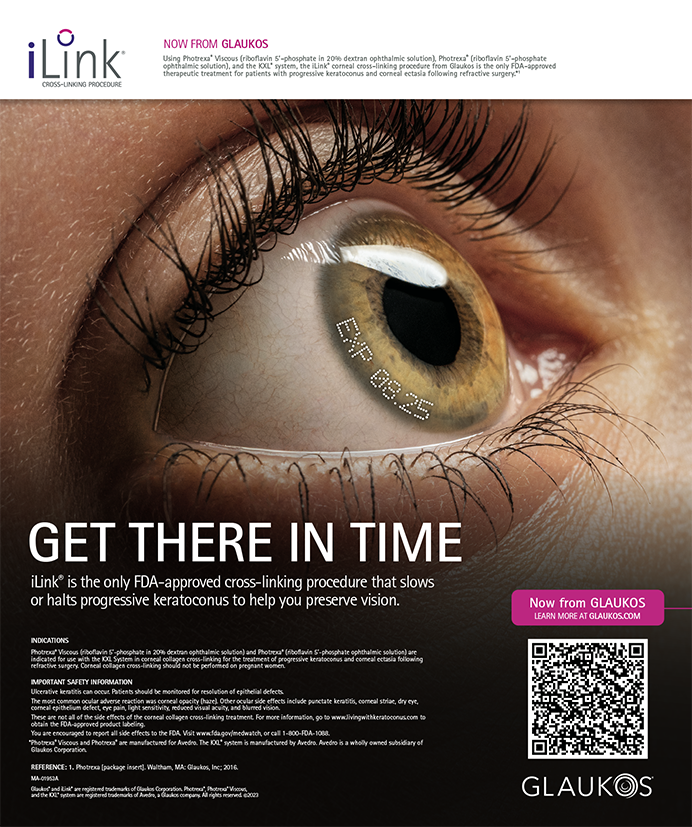Minimizing the risk of postoperative endophthalmitis requires the elimination of or a significant reduction in the bacterial flora that are found on the ocular surface at the time of surgery and during the immediate postoperative period. The major source of bacteria that cause endophthalmitis is a patient's own eyelids and conjunctiva.1,2 Applying povidone-iodine at the time of surgery can decrease ocular bacteria.3-14 Topical antibiotics administered for several days and immediately prior to surgery provide an additional killing of bacteria beyond the effects of povidone-iodine,7,8,13-16 although a prospective randomized study has yet to prove that the use of topical antibiotics reduces the risk of endophthalmitis. Regardless, almost all ophthalmologists prescribe topical antibiotics for patients undergoing intraocular surgery. Ophthalmologists also use antibiotics postoperatively to minimize the risk of bacteria's entering the eye via the surgical wound. This is of particular concern with clear corneal incisions, because the wound may not be watertight.17,18 In addition, frequently applying a topical antibiotic may allow the drug to achieve levels in the aqueous that are high enough to kill the bacteria that contaminate the anterior chamber at the time of surgery.19-29 According to a rabbit study,30 Vigamox (Alcon Laboratories, Inc., Fort Worth, TX) administered in both the pre- and postoperative period can prevent the development of endophthalmitis following inoculation with Staphylococcus aureus. The ideal topical antibiotics for minimizing the risk of postoperative endophthalmitis must have the following characteristics: broad-spectrum coverage of both gram-positive and gram-negative bacteria; bacteriocidal properties for quick kills of bacteria upon contact; and excellent penetration to achieve intraocular levels that are sufficiently high to kill the offending bacteria. The agent must also be nontoxic to the ocular surface and cost effective. Several classes of antibiotics are currently available in the US and include the combination therapy of polymixin B and trimethoprim, the aminoglycosides, and the fluoroquinolones. Many ophthalmic ointments are also available, including erythromycin and the combination therapy of bacitracin and polymyxin B. Of all of these antibiotics, fluoroquinolones, in my opinion, may be the most appropriate antibiotics for endophthalmitis prophylaxis. The greatest advantages of these drugs over other classes of antibiotics are that they provide broad-spectrum coverage, are bacteriocidal and nontoxic, and penetrate the anterior chamber well. In contrast, other antibiotics such as polymixin B and trimethoprim are bacteriostatic, and aminoglycosides carry some risk of toxicity. Among the commercially available topical ophthalmic fluoroquinolones, ciprofloxacin and ofloxacin have limited gram-positive coverage. The newer fluoroquinolones?specifically Quixin (Santen Inc., Napa, CA), Zymar (Allergan, Inc., Irvine, CA), and Vigamox?have enhanced activity toward gram-positive pathogens while maintaining broad-spectrum coverage against gram-negative organisms.31-36 They interfere with both topoisomerase II and IV, and bacterial resistance appears to be lower since mutations of both enzymes are necessary.32 After reviewing the published literature for the most desirable properties of commercially available antibiotics, I found some minor differences between them. In general, the three most recently FDA-approved antibiotics (Quixin, Zymar, and Vigamox) are excellent antibiotics. Some of their important characteristics include low resistant rates, high efficacy and kill time, reduced surface toxicity, and effective aqueous penetration. This article discusses the off-label use of the approved products Quixin, Zymar, and Vigamox. ANTIBIOTIC SUSCEPTIBILITY 200 institutions since 1999. In this comprehensive study, 99 of Streptococcus pneumoniae remained susceptible to Quixin despite more than 9 years of extensive systemic use. Currently, ocular isolates are collected and analyzed to determine trends in resistance for the commonly prescribed topical antibiotics in the TRUST study. EFFICACY IN KILLING BACTERIA As with any topical antibiotic, the goal is to eradicate the bacteria as quickly as possible. There is some recent evidence suggesting that the preservative benzalkonium chloride (BAK) may have a synergistic effect in improving an agent's kill time.45-48 A recent in vitro study45 demonstrated that 0.005 BAK alone or 0.3 gatifloxacin with 0.005 BAK (Zymar) kills Staphylococcus epidermidis and S. aureus within 1 hour, compared with 4 hours for 0.5 moxifloxacin alone (Vigamox)45 (Figure 1). Another study demonstrated similar results, with Zymar eliminating all Staphylococcus within 60 minutes, whereas 50 of the bacteria treated with Vigamox remained.46 Other clinical studies have confirmed the slow kill rate of Vigamox (Figure 2). In a study47 of 60 patients undergoing intraocular surgery, after a 1-hour application of Vigamox preoperatively, there was no effect on killing bacterial flora on the ocular surface. At baseline, 55 of eyes had positive cultures compared with 53 of the eyes after treatment with Vigamox for 1 hour. In contrast, my colleagues and I will report a study at this year's ARVO Annual Meeting in which a 1-hour preoperative application of Zymar significantly decreased the rate of bacterial contamination of the conjunctiva in patients undergoing intraocular surgery from a baseline of 75 to 40. These studies suggest that antibiotics preserved with BAK may be much more efficacious in the rapid killing of bacteria compared with antibiotics without BAK. Quixin, which is 0.5 levofloxacin and 0.005 BAK, and Zymar therefore may kill bacteria much quicker than Vigamox. TOXICITY In contrast to the aforementioned studies, Burka et al51 conducted a prospective, masked, randomized study comparing Zymar and Vigamox in patients undergoing PRK. The investigators found that eyes treated with Vigamox healed faster and had smaller epithelial defects compared with those treated with Zymar. Of course, no corneal incision is created during the refractive procedure. In another PRK study,52 no difference was found with respect to haze, visual acuity, or epithelial healing between eyes treated with Zymar and Vigmox. Finally, Walter and Tyler53 reported two patients with worsening and persistent corneal ulcers as well as endothelial cell dysfunction while on Vigamox. The patients' conditions resolved after the discontinuation of Vigamox and the initiation of Zymar and corticosteroid treatment. Adverse side effects are rare with the topical fluoroquinolones. For most patients, Quixin, Zymar, and Vigamox are safe medications. In patients with compromised wound healing ability?such as those with ocular surface disease, dry eyes, and neurotrophic corneas, among other conditions?the surgeon needs to consider the potentially toxic effects of Vigamox. AQUEOUS PENETRATION Figure 3 summarizes the results of a study by Ong-Tone.64 IN SUMMARY The choice of antibiotic depends on the clinical situation. To quickly kill bacteria, those drugs preserved with BAK, such as Zymar and Quixin, may be indicated. Vigamox has better penetration into the aqueous humor, however, and may be more appropriate in eyes for which bacterial contamination of the anterior chamber is likely, although some evidence suggests that the drug may impair wound healing. Based upon the literature mentioned herein, the later generations of topical fluoroquinolones represent the best of the available antibiotics. Christopher N. Ta, MD, is Associate Professor and Director of Residency Program, Cornea and External Diseases, Department of Ophthalmology, Stanford University School of Medicine, Stanford, California. He is consultant for Vistakon and Allergan, Inc., and has received unrestricted research and educational gifts from Allergan, Inc. Dr. Ta may be reached at (650) 725-5743; cta@stanford.edu. |
Up Front | Apr 2007
What are the Best Topical Agents for Prophylaxis?
The top antibiotics are those that are most effective against the majority of bacteria, rapidly kill the offending organisms, penetrate the eye well, and are nontoxic.
Christopher N. Ta, MD


